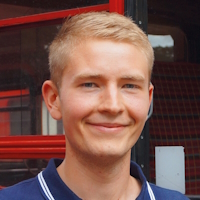Meet our guides: Tobias
Guide since: October 2022
Position: Masters student for VITO at ISOLDE (User, University of Oldenburg)
Languages: German, English
 One thing that makes being a CERN guide so interesting and exciting is the diversity of our visitors. You might have a super-interested 10 year-old, for whom the visit to CERN is his birthday present, or you could find yourself discussing the connection between Buddhism and the Higgs boson with a monk.
One thing that makes being a CERN guide so interesting and exciting is the diversity of our visitors. You might have a super-interested 10 year-old, for whom the visit to CERN is his birthday present, or you could find yourself discussing the connection between Buddhism and the Higgs boson with a monk.
One visit that I remember vividly was with a group of Swiss–German retirees. All of the visitors were hard of hearing, with the majority of them being deaf. To facilitate communication they brought two sign-language translators with them. Before the start of the tour some of the visitors were concerned that their cochlear implants, which can restore some hearing, might be influenced by CERN’s equipment. Luckily, I studied medical physics and audiology before coming to CERN, so I was able to reassure them that everything will be fine. On that day we were showing the group the Synchrocyclotron and the ATLAS Visitor Centre. Communicating via the translators was something that was completely new for me, as I am sure terms such as muon spectrometer or superconducting magnet were to them. Due to the translation, it naturally took a few seconds longer than usual to see the audience’s reaction. In most cases, however, it was full of excitement and often more effusive than with a group of hearing visitors. Many questions were asked and a lot of photos were taken, later to be shown to their grandchildren.
Although the tour took much longer than planned, I do not regret a single second I got to spend with them. When the group finally left CERN, there was not only a bright smile on their faces but on mine as well. Engaging people in our research and making it accessible to everybody regardless of their background, age or impairments is something which to me is a vital part of CERN’s mission.
